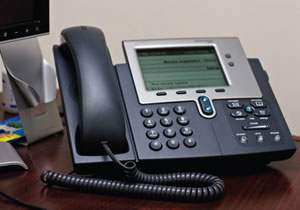Communication Upgrades
- By Frederic Dickey
- 02/01/16

PHOTO © LEO_PHOTO/SHUTTERSTOCK
Telecommunications costs account for a significant portion of school district budgets. At the same time, administrators are faced with limited resources when it comes to upgrading their phone systems.
Due to budgetary restrictions, many school districts continue to work with very antiquated equipment. In recent years however, we have seen a large wave of districts starting to migrate to voice over IP (VoIP). While VoIP offers many advantages — from improved efficiency to lower capital costs — many districts are finding that the transition is not always an easy one.
A case in point is Lake Superior School District in Minnesota that recently decided to switch to VoIP. The 14-year-old phone system being used by its three school sites was out of warranty and replacement parts were no longer available.
“Like most school districts, we have a tight budget. So we needed a cost-effective system that we could customize internally,” says Kristen Lee, the district’s Technology director. “It had to be robust enough to handle the size of our school district, and be easy to manage as I am the only one here to take care of its maintenance.”
They initially decided to go with a proposal from a hosted system provider. Unfortunately, after two months of trying to work through one problem after the next to get the system installed, the district decided to pull the plug and bring its VoIP management in-house.
“It was a very chaotic start of the school year that I don’t want to ever repeat,” Lee explains. “They couldn’t get caller ID to work; couldn’t get certain phones to work; and couldn’t work with our firewall settings. They would fix one thing and then wouldn’t be able to fix the next problem. They couldn’t deliver the functionality they promised in their proposal.”
Armed with the knowledge of how many things could go wrong with a phone system, and how disruptive this could be to the schools, the district chose to go to an on-premise solution they could manage internally. Because it had just purchased 200 new IP phone handsets, compatibility with this hardware was an important factor in choosing the new direction.
The key challenge was that the original provider did not enable onsite integration for the schools’ paging and fax systems. In addition, with the particular solution they had, when any moves, adds, changes or deletions to the phone system were needed, they would have to submit tickets and wait days for a response.
The first order of the day was to finalize an onsite solution that integrated properly with the schools’ paging and fax systems. One particular challenge was a paging amplifier that was installed in the 1980s. It took a considerable amount of time and digging through manuals to figure out an interface — a common problem when working with aging systems and brands.
The changeover to the on-premise system was completed in one and a half days over a weekend. The district now has two PBX gateways to enable web-based management of the system. The fax integration issue was resolved with the implementation of a cloud-based fax gateway service that allows analog-based fax machines to work with an IP infrastructure.
According to Lee, this latest enhancement made all the difference in the world. “With the new system it has been easy for me to create ring groups and add new users including extension changes. I don’t have to fill out a ticket and wait days for it to be completed; I can handle it myself. I have been able to do real time monitoring, and reboot and reset a phone if needed. I can adjust email settings to get voice mail to email for those who want it, or change sound notifications for voice mail. These are a lot of tiny things, but in a classroom if the phone isn’t behaving the way you want it to, it can cause a lot of disruptions. The approach we’ve taken makes a big difference.”
In addition to the new-found hardware compatibility, the district has the option of using any local phone provider they choose, so they can put the phone service out to bid every year according to government regulations. An added advantage is that the district now owns the system so does not have to pay license fees every year, and there is no annual maintenance fee.
“If I need someone to come in for a software upgrade, it is a very reasonable hourly rate so we don’t pay for services we don’t need to use. But the system is easy to run ourselves and I don’t need a lot of help,” she says. “I feel this is a system that will be very stable for years to come. I like the fact that it is an open source platform that will supported down the road.”

PHOTO © MARIUSZ S. JURGIELEWICZ/SHUTTERSTOCK
Problem Solved. When the Lake Superior School District in Minnesota decided to upgrade their antiquated phone system it seemed only logical to convert to VoIP (voice over IP). That wasn’t as simple as they thought it would be. But, with a little bit of trial and error, and research, they came up with an in-house system that serves their needs, allows them to be more compliant with government regulations and will be easier on their tight budget.
Tim Nelson, system engineer with Sangoma Technologies, says these types of issues are not uncommon with schools transitioning to VoIP. Having worked with numerous school districts on VoIP transitions, he offers some words of advice before making any investment decisions. The first is understanding your infrastructure.
“The biggest issue for many is making sure the infrastructure in schools can handle the addition of VoIP handsets in each room. Most have single Cat5 [cable] running to the classrooms, which can be a challenge with VoIP solutions,” he explains. “You must ensure you can have separate Cat5 runs to each handset.”
The second is capacity and future-proofing. The network, including routers and firewalls, must be able to support additional traffic and power loads. School districts should also keep in mind that if they need more capacity down the road, they may have to add more copper runs which can mean significant costs and time.
Nelson notes that some school districts are now looking to SIP (session initiation protocol) trunking, which is available through Internet telephony service providers, as a means to save costs and improve efficiencies. Not only is it much easier to add capacity, SIP trunking enables a broad range of unified communications applications, including voice, video, desktop sharing, web conferencing and other media sharing applications.
“SIP trunking is more flexible if capacity needs change,” Nelson explains. “With traditional lines you need to get more copper runs in. With SIP you simply call you provider and instantly increase the number of calls you can take at a time.”
When starting a project, he suggests conducting a complete site survey that includes listing all extensions, voice mail passwords, IVR (integrated voice response) and other features that you need for the new system. “It’s essential to know how the flow of the phone system works. For example, do you want to maintain your existing three-digit structure? How do you want to set up your intercom and paging functions? Do you have any time-based rules around after-hour phone calls? What legacy systems do you want to keep? These are all questions that need to be answered before you start implementing.”
A thorough review will clarify what hardware elements need to be added to ensure optimum network performance and security, and determine if an on-premise or hosted solution would work best for the district’s needs.
Establishing the groundwork before making the transition to VoIP can go a long way towards helping school districts avoid added expense and complexities, Nelson says. “VoIP can be a relatively easy transition… if you get it right the first time.”
This article originally appeared in the issue of .